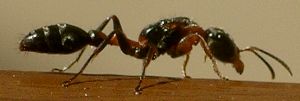
the Twig Ant, known for its painful sting
 the Twig Ant, known for its painful sting |
Another similar situation arises with scorpions. This group of arthropods are arachnids, related to spiders, mites and ticks. All arachnids have eight legs. But if you ever looked closely at a scorpion, you would see that it walks on four pairs of legs and also has a pair of claws that are even larger than its legs. The explanation for this anomaly is that, like spiders, scorpions have an extra pair of appendages associated with their mouthparts. These are called pedipalps. While those of spiders often look like small extra legs on their head, those of scorpions have evolved into large claws, capable of grasping and pinching.
 a Velvet Ant - the Cow Killer |
Insects' array of appendages also includes wings. The basic insect body plan includes two pairs. Obviously, this has many modifications among the diverse groups. The first pair of wings on beetles have evolved into protective coverings (called elytra) to shield the more fragile pair of flight wings when they are not being used. The second pair of wings on true flies have become small club-like knobs called halteres which act as balance organs during flight. And then there are a number of insects that do not have wings at all.
Many flightless insects are considered primitive, and retain characteristics of the very first insect ancestors, before the evolution of wings. There are also insects that have lost their wings because they are not needed in their particular habitat niches. Flight is often not desirable, or might even be detrimental, to insects living in very cold climates or on islands. Growing wings takes energy, so if certain kinds of insects do not need them, it is more practical to not have them in the first place.
Ants live underground in highly social colonies. The majority of ants need never fly anywhere, so they do not have wings. Only the future queens and the males that will provide them with sperm have wings. As soon as an alate (the term for a winged individual) has mated, it either dies, in the case of males, or, as a new queen, rids itself of the wings and starts an underground colony. If you are wondering why it is taking awhile to get to the subject of wasps, we are there. Ants belong to a single family (Formicidae) that is closely related to several other families of wasps. Ants actually can be thought of as a type of wasp, and many can sting. If you have any experience with fire ants and red harvester ants, you know what I mean.
 a dryinid wasp ovipositing on a hapless leafhopper |
Not all wingless wasps have stings that can hurt large animals such as ourselves. Some species are so tiny that they pose no threat except to their prey. While adult wasps of all kinds feed on nectar and other sweet substances, their babies (grubs) need flesh, so the mother wasps must provide nourishment by hunting. Some kinds of wasps kill insects and spiders and take the remains back to a nest for the young. Others paralyze unfortunate arthropods and then leave them in a burrow with an egg; when the grub hatches, it will have a fresh store of food. Many wasps, especially small species, lay their eggs on living insects and the grubs feed on their host until they are full grown. One kind of wasp in this last category is in the family Dryinidae. Members of this group parasitize planthoppers, which are pretty small bugs. As you might imagine, the wasps are equally tiny. The female wasps have no wings and simply catch their prey by running after it, just like ants. Since laying an egg on a live insect is tricky business, the wasp I observed conveniently stung and paralyzed the leafhopper before attempting to oviposit. It then used its powerful front legs to manipulate the victim until it could place an egg just where it wanted - on the soft underside between the abdominal segments. After the wasp finished her task, the leafhopper would presumably revive, continue to move about and feed, all the while providing sustenance for its unwanted guest.
 a female ichneumon in the genus Gelis |
One of the biggest families of wasps is Ichneumonidae. Many of its members sport long ovipositors but very few can actually sting. These are some of the most brightly colored insects around, as if they have overdone the signals that warn off predators. Most ichneumons have wings and resemble their more venomous wasp cousins, but one genus (Gelis) has mostly wingless females. These are so similar in size and appearance to ants that it is hard to recognize them for what they are. As ants, being social and well-protected chemically, have relatively few predators, this mimicry is certainly an advantage to the ichneumons.
I find that wasps are one of the most fascinating groups of insects, both in morphology and lifestyles. Those that have lost their wings present a curious glimpse into the complex relationships between predators, prey, and their environment.